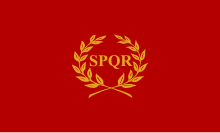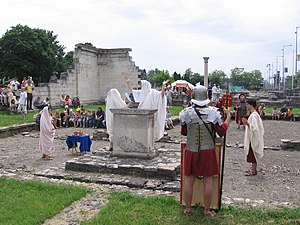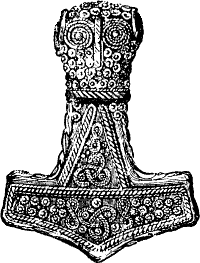
Heathenry is a modern Pagan new religious movement that has been active in the United States since at least the early 1970s. Although the term "Heathenry" is often employed to cover the entire religious movement, different Heathen groups within the United States often prefer the term "Ásatrú" or "Odinism" as self-designations.

Modern paganism, also known as contemporary paganism and neopaganism, is a type of religion or family of religions influenced by the various historical pre-Christian beliefs of pre-modern peoples in Europe and adjacent areas of North Africa and the Near East. Although they share similarities, contemporary pagan movements are diverse and as a result, they do not share a single set of beliefs, practices, or texts. Scholars of religion often characterise these traditions as new religious movements. Some academics who study the phenomenon treat it as a movement that is divided into different religions while others characterize it as a single religion of which different pagan faiths are denominations.
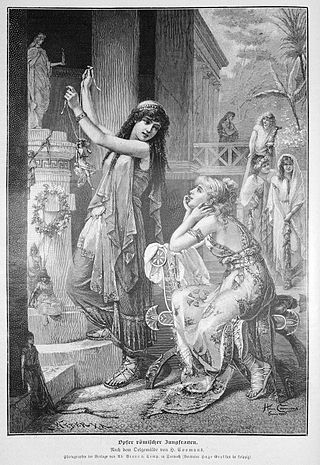
Paganism is a term first used in the fourth century by early Christians for people in the Roman Empire who practiced polytheism, or ethnic religions other than Judaism. In the time of the Roman Empire, individuals fell into the pagan class either because they were increasingly rural and provincial relative to the Christian population, or because they were not milites Christi. Alternative terms used in Christian texts were hellene, gentile, and heathen. Ritual sacrifice was an integral part of ancient Graeco-Roman religion and was regarded as an indication of whether a person was pagan or Christian. Paganism has broadly connoted the "religion of the peasantry".

In religious studies, an ethnic religion is a religion or belief associated with a particular ethnic group. Ethnic religions are often distinguished from universal religions, such as Christianity or Islam, in which gaining converts is a primary objective and, therefore, are not limited in ethnic, national or racial scope.

Romuva is a neo-pagan movement derived from the traditional mythology of the Lithuanians, attempting to reconstruct the religious rituals of the Lithuanians before their Christianization in 1387. Practitioners of Romuva claim to continue Baltic pagan traditions which survived in folklore, customs and superstition. Romuva is a polytheistic pagan faith which asserts the sanctity of nature and ancestor worship. Practicing the Romuva faith is seen by many adherents as a form of cultural pride, along with celebrating traditional forms of art, retelling Baltic folklore, practicing traditional holidays, playing traditional Baltic music, singing traditional dainos (songs), as well as ecological activism and stewarding sacred places.

Ancient Celtic religion, commonly known as Celtic paganism, was the religion of the ancient Celtic peoples of Europe. Because there are no extant native records of their beliefs, evidence about their religion is gleaned from archaeology, Greco-Roman accounts, and literature from the early Christian period. Celtic paganism was one of a larger group of polytheistic Indo-European religions of Iron Age Europe.
Baltic neopaganism is a category of autochthonous religious movements which have revitalised within the Baltic people. These movements trace their origins back to the 19th century and they were suppressed under the Soviet Union; after its fall they have witnessed a blossoming alongside the national and cultural identity reawakening of the Baltic peoples, both in their homelands and among expatriate Baltic communities, with close ties to conservation movements. One of the first ideologues of the revival was the Prussian Lithuanian poet and philosopher Vydūnas.

Polytheistic reconstructionism is an approach to modern paganism first emerging in the late 1960s to early 1970s, which gathered momentum starting in the 1990s. Reconstructionism attempts to re-establish genuine polytheistic religions in the modern world through a rediscovery of the rituals, practices and contextual worldviews of pre-Christian pagan religions. This method stands in contrast with other neopagan syncretic movements like Wicca, and ecstatic/esoteric movements like Germanic mysticism or Theosophy.

Celtic neopaganism refers to any type of modern paganism or contemporary pagan movements based on the ancient Celtic religion. One approach is Celtic Reconstructionism (CR), which emphasizes historical accuracy in reviving Celtic traditions. CR practitioners rely on historical sources and archaeology for their rituals and beliefs, including offerings to spirits and deities. Language study and preservation are essential, and daily life often incorporates ritual elements. While distinct from eclectic pagan and neopagan witchcraft traditions, there is some overlap with Neo-druidism.

Paganism is commonly used to refer to various religions that existed during Antiquity and the Middle Ages, such as the Greco-Roman religions of the Roman Empire, including the Roman imperial cult, the various mystery religions, religions such as Neoplatonism and Gnosticism, and more localized ethnic religions practiced both inside and outside the empire. During the Middle Ages, the term was also adapted to refer to religions practiced outside the former Roman Empire, such as Germanic paganism, Egyptian paganism and Baltic paganism.
Modern paganism in the United States is represented by widely different movements and organizations. The largest modern pagan religious movement is Wicca, followed by Neodruidism. Both of these religions or spiritual paths were introduced during the 1950s and 1960s from Great Britain. Germanic Neopaganism and Kemetism appeared in the US in the early 1970s. Hellenic Neopaganism appeared in the 1990s.

Revivals of the ancient Roman polytheistic religion have occurred in several forms in modern times. Seeking to revive traditional Roman cults and mores, they have been known under various names including cultus deorum Romanorum, religio Romana, the Roman way to the gods, Roman-Italic Religion and Gentile Roman Religion. A number of loosely related organizations have been created during the contemporary period.
Semitic neopaganism is a group of religions based on or attempting to reconstruct the ancient Semitic religions, mostly practiced among Jews in the United States.
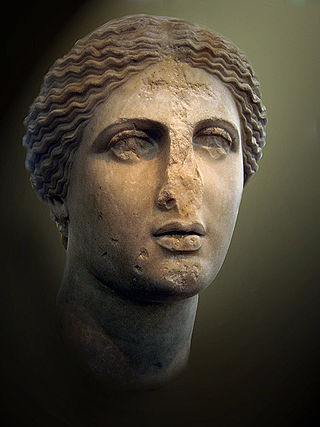
Persecution of pagans in the late Roman Empire began during the reign of Constantine the Great in the military colony of Aelia Capitolina (Jerusalem), when he destroyed a pagan temple for the purpose of constructing a Christian church. Rome had periodically confiscated church properties, and Constantine was vigorous in reclaiming them whenever these issues were brought to his attention. Christian historians alleged that Hadrian had constructed a temple to Venus on the site of the crucifixion of Jesus on Golgotha hill in order to suppress Christian veneration there. Constantine used that to justify the temple's destruction, saying he was simply reclaiming the property. Using the vocabulary of reclamation, Constantine acquired several more sites of Christian significance in the Holy Land.

Modern Paganism in World Cultures: Comparative Perspectives is an academic anthology edited by the American religious studies scholar Michael F. Strmiska which was published by ABC-CLIO in 2005. Containing eight separate papers produced by various scholars working in the field of Pagan studies, the book examines different forms of contemporary Paganism as practiced in Europe and North America. Modern Paganism in World Cultures was published as a part of ABC-CLIO's series of books entitled 'Religion in Contemporary Cultures', in which other volumes were dedicated to religious movements like Buddhism and Islam.
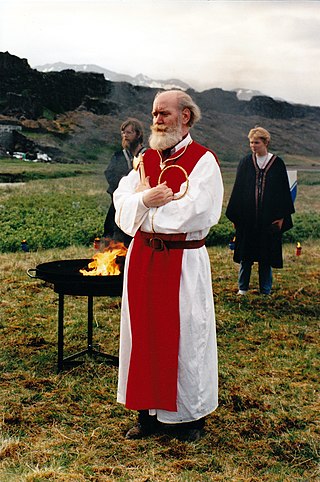
Jörmundur Ingi Hansen is an Icelandic neopagan leader, designer, businessman and clothing retailer. Trained as a sculptor and known as a prominent member of Reykjavík's hippie scene, he co-founded the Icelandic neopagan organization Ásatrúarfélagið in 1972, co-creating its rituals, liturgy and clothing. From 1994 to 2002, he led the organization, holding the title allsherjargoði; during his time in office, Ásatrúarfélagið experienced significant membership growth, acquired a building in Reykjavík and constructed a pagan burial ground designed by Jörmundur. An internal conflict led to his removal from the position, and in 2004 he left and became the leader of a small splinter group.
Volodymyr Petrovych Shaian was a Ukrainian linguist, philologist and Orientalist-Sanskritologist. He was a pioneer of Slavic Native Faith in Ukraine during the interwar period.
Modern paganism, also known as contemporary paganism and neopaganism, is a collective term for new religious movements which are influenced by or derived from the various historical pagan beliefs of pre-modern peoples. Although they share similarities, contemporary pagan religious movements are diverse, and as a result, they do not share a single set of beliefs, practices, or texts.
I Still Worship Zeus is a Greek documentary film about modern worship of the gods of ancient Greek religion and mythology. It was directed by Jamil Said and premiered in 2004.
